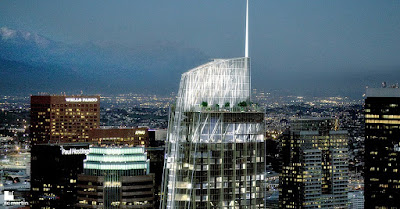After three years
of hard work and 744 days since the historic mat pour, the “Wilshire Grand Core
and Steel Topping Out” ceremony was celebrated on March 8, 2016. Workers from the construction project’s
manager, Turner Construction, The Conco Companies and officials from the
project’s architect, AC Martin Partners, representatives from the project’s
owner’s, Korean Air, and others were on-hand to celebrate the event.
The ceremony
consisted of lifting the last steel beam into place, which had been signed by all
of the workers, owners and a group of dignitaries. The beam, weighing 2,100 pounds and 35 feet
long, had been trucked in from Eloy, Arizona.
In following with the tradition, a U.S. flag and tree was placed on top of
the beam. The tradition of holding a topping
out ceremony began as a religious rite that is traced back to ancient
Scandinavia. The practice of placing a
tree on top of a newly finished building was done to appease tree-dwelling
spirits that had been displaced during the construction.
Chris Martin, the
lead architect on the project, noted there is still much work to do on the
project. However, he added that they
would be here again next year on March 8, 2017 in another ceremony to celebrate
the completion of the building. This
date is not just coincidental, but the birthday of Yang Ho Cho, chairman of
Hanjin International Corp, which owns Korean Air.
The completion of
the 73-story concrete core signifies a major achievement in the project. At 892-ft. high, the concrete core required
32,000 cubic yards of concrete and 50 million pounds of rebar to construct. When finished, the Wilshire Grand will be the
tallest building in the U.S. west of the Mississippi River.
The Conco Companies’ goal is to be the best supplier of commercial concrete
services for the Western U.S. We bring our extensive expertise and
professionalism to each project and continue to upgrade and expand facilities
to better serve the growing market. Before you start your next project,
please contact us for more information about our trusted commercial concrete
services.
Source: latimes.com/local/california/la-me-adv-wilshire-grand-topping-out-20160313-story.html


